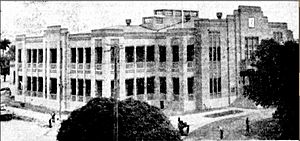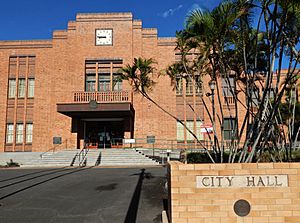Rockhampton Town Hall facts for kids
Quick facts for kids Rockhampton Town Hall |
|
|---|---|

Rockhampton City Hall, 2020
|
|
| Location | 232 Bolsover Street, Rockhampton City, Rockhampton, Rockhampton Region, Queensland, Australia |
| Design period | 1919 - 1930s (interwar period) |
| Built | 1939 - 1941 |
| Built for | Rockhampton City Council |
| Architect | Hockings & Palmer |
| Architectural style(s) | Classicism |
| Official name: Rockhampton Town Hall, Rockhampton City Hall, Rockhampton Council Chambers | |
| Type | state heritage (landscape, built) |
| Designated | 29 April 2003 |
| Reference no. | 601572 |
| Significant period | 1930s-1940s (historical) 1939 - ongoing (social) 1940s (fabric) |
| Significant components | views to, foyer - entrance, furniture/fittings, office/s, garden/grounds, council chamber/meeting room, trees/plantings |
| Builders | John Hutchinson (J. Hutchinson & Sons - now Hutchinson Builders) |
| Lua error in Module:Location_map at line 420: attempt to index field 'wikibase' (a nil value). | |
The Rockhampton Town Hall is a special building in Rockhampton, Queensland, Australia. It's a "heritage-listed" building, which means it's important to history and protected. This grand building is where the local government, the Rockhampton City Council, works. It's also known as Rockhampton City Hall or Rockhampton Council Chambers.
It was designed by the architects Hockings & Palmer and built between 1939 and 1941. The builders were John Hutchinson and his company, J. Hutchinson & Sons (now called Hutchinson Builders). The Rockhampton Town Hall was added to the Queensland Heritage Register on April 29, 2003.
Contents
A Look Back: History of the Town Hall
Rockhampton became an important city in Queensland in the 1850s and 1860s. It grew even more after gold was found at Mount Morgan in 1882. This wealth helped Rockhampton build many new public and private buildings. Even with all this growth, Rockhampton didn't have a special building just for its town hall until 1941.
In 1878, the Rockhampton Council used a simple wooden and iron building. One mayor even called it a "Temporary Town Hall." They also had a fire engine shed and a kerosene store nearby.
Planning the New Town Hall
On June 21, 1897, a special stone was laid for a future town hall. This was to celebrate Queen Victoria's Diamond Jubilee. The mayor, Mr. Littler, said they couldn't start building right away. He hoped construction would begin within the next ten years.
However, it took much longer. It wasn't until 1936 that the Council finally asked architects for designs. Seven different designs were sent in by architects from Rockhampton and Brisbane. But none of them were quite right, mainly because of the cost.
Finally, an updated design from a local firm, Hockings and Palmer, was chosen. The building contract went to John Hutchinson and Sons from Brisbane.
The Architects: Hockings & Palmer
Edwin Morton Hockings (1870-1942) was a key architect for the Town Hall. He started his career in Brisbane. In 1890, he won a competition to design the new Rockhampton Girls Grammar School. He then moved to Rockhampton to work on that project.
Hockings opened his own architecture business in Rockhampton in 1895. He designed many buildings across Central Queensland. He even served in the Anglo-Boer War and World War I. Later, he formed a successful partnership with Leslie Tarween Palmer from 1916 to 1938. This was the firm Hockings and Palmer.
The Rockhampton Town Hall was Edwin Hockings' last major project. He lived to see it finished before he passed away in 1942.
Building the Town Hall
On February 25, 1939, Rockhampton's Mayor, Mr. R. Will Evans, started the building work. A month later, on March 25, the foundation stone was laid. Building took two years, partly because of a shortage of materials and bad weather.
The new Town Hall cost about £50,000. When it was finished, it was described as a "massive block." It was bigger and grander than any other civic building in Queensland outside of Brisbane.
The Town Hall During World War II
During World War II, the Town Hall played an important role. From August 1942, it became the main office for General Robert L. Eichelberger. He was in charge of the 41st Infantry Division of the United States Army.
The Rockhampton City Council worked closely with both Australian and American army leaders. By doing so, the Town Hall helped Australia's defense during the war in the Pacific.
Today, the Rockhampton Town Hall is still the main office for the Rockhampton Regional Council. It continues to be a very important building for the city.
What the Town Hall Looks Like
Rockhampton's Town Hall is a grand, two-story building. It's made of brick and sits on a strong granite base. The building is in the city center, on Bolsover Street. It has large, open grounds around it, with green lawns and tall, old trees. You can see Cuban Royal Palms and Traveller's Palms growing there.
The building has four sides, or "facades," that look similar. They are made of brick and have projecting parts and balconies. Many of these balcony areas have been filled in over time. The main entrance faces Bolsover Street. The other sides can be seen from Derby, Alma, and William Streets.
Details of the Building's Design
The brickwork is laid in a special pattern called Flemish bond. Darker bricks are used to highlight certain lines and the top of the walls. This gives the building a classic, strong look.
The main entrance is in the middle of the Bolsover Street side. You walk up wide granite steps to reach it. Above the entrance is a metal cover, or "awning," with the city's coat of arms on it. Above the awning, there's a small balcony and a clock made of ceramic tiles.
Inside the glass entrance doors, you enter the main lobby, called the "foyer." It has marble walls up to door height and a high plaster ceiling. From the foyer, a wide wooden staircase leads upstairs. A window above the stairs lets in lots of light.
Upstairs, you'll find the Council Chamber. This is where the local council members meet. It has high wooden walls, wooden floors, and a high plaster ceiling with decorative beams.
Why the Town Hall is Special: Heritage Listing
The Rockhampton Town Hall was added to the Queensland Heritage Register on April 29, 2003. This means it's recognized as an important historical place for several reasons:
- Shows Queensland's History: The Town Hall clearly shows how local government developed in regional centers like Rockhampton. It was built specifically to meet the needs of the city's council.
- A Great Example of Its Kind: This building is a perfect example of a town hall designed for a regional city. It shows how buildings were made to work for the council and suit the local climate.
- Beautiful and Important: People in Rockhampton and beyond value the Town Hall for its beauty. It stands out in the city center. It's a large, impressive public building with classic and Art Deco design elements.
- Connected to the Community: The Town Hall is very important to the Rockhampton community. It's where many social and cultural events happen. It's also the last major work by the famous local architect, Edwin Morton Hockings. Plus, it has a special connection to all the council staff, mayors, and aldermen who have worked there over the years.



